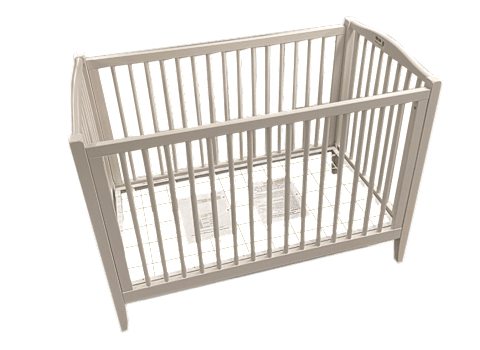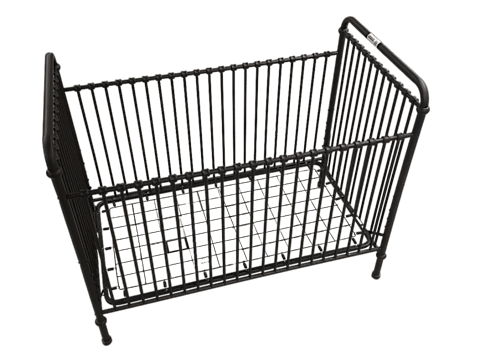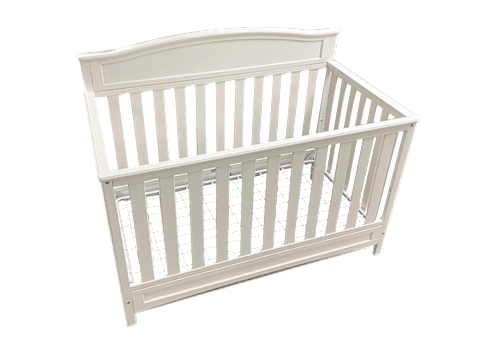Consumer Reports tested nine, including convertible cribs and popular models from Pottery Barn, Ikea, Delta, Nestig, and other brands

By Angela Lashbrook
A crib is likely to be one of the first things you’ll purchase when you have a baby on the way. This makes it one of the most exciting—and possibly stressful—products you’ll ever buy for your kid. Thankfully, new cribs sold in the U.S. must conform to safety standards set by the Consumer Product Safety Commission, so the primary criteria should come down to budget, aesthetics, construction quality, and ease of assembly (because anyone who’s ever put together Ikea furniture knows how crucial this is).
So what should you consider when choosing the bed where your little one will spend most of their time in their first few months of life? We’ve broken down the basics below, but for a more comprehensive look, check our cribs buying guide. There, you’ll find information about different crib prices, a look at how we tested models, shopping and safety features, and more.
Before we get to the fun stuff, though, remember that no matter what crib you choose, you should always keep safe sleep practices in mind. That can be boiled down to a few simple rules:
- Babies should sleep on a firm, flat, non-inclined surface. Inclined surfaces can cause babies to suffocate.
- The baby should sleep by themselves in their sleep space, never with another person. Babies can roll into crevices in sleep spaces, such as between a mattress and a headboard, or be smothered by pillows or their parent rolling over.
- Do not put toys, crib bumpers, blankets, pillows, or other products in the crib with the baby. These products can suffocate babies.
Three Things to Look for in a New Crib
As you stroll your local department store or scroll through an online baby gear shop, there are a few things you’ll want to keep in mind.
Avoid Buying (or Borrowing) a Used Crib
If for any reason you must buy (or borrow) a used crib, make sure it’s a stationary-side crib manufactured after 2013, because federal safety standards for stationary-side cribs went into effect in 2011 (the two additional years provide a bit of safety wiggle room). Check the crib for a label that includes the model number and the manufacturing date or lot code, as well as contact info for the manufacturer. Typically, these codes appear in a discreet spot on the crib frame, or underneath the mattress support. If you can’t decipher the manufacturing date from the lot number or lot code, call the manufacturer and ask. If there’s no clear label, don’t use the crib.
“Sometimes a used crib may be passed on to you disassembled,” says Joan Muratore, test program leader at Consumer Reports. “I’d be very nervous about that because you won’t know if there’s missing hardware unless you have the assembly instructions.” The same goes for “open box” cribs that were previously bought and returned; they could be missing parts, so it’s best to avoid purchasing these. Drop-side cribs, which allow for one side of the crib to temporarily lower to provide easier access to the baby, are dangerous and have been banned since 2011. Do not use drop-side cribs.
Make Sure the Crib Isn’t too High for You and Other Primary Caregivers
Cribs that are too high off the ground make it difficult for shorter parents to comfortably access their child. “If a store has a floor model of the crib you’re considering, lean over the rail as if you’re picking a baby up from inside the crib to see whether the crib’s rail height is a good fit for your height,” Muratore says.
Check That the Mattress Fits the Crib
If the crib is too big for the mattress, the baby could become trapped and suffocate. “If you can fit more than two fingers between the crib frame and the mattress, the mattress is too small,” says Muratore. If that’s the case—time for a new mattress.
How Consumer Reports Tests Cribs
Muratore’s team took a streamlined approach to testing these cribs, focusing on three main criteria: How easy is the crib to assemble? Is it quality construction? And how easy is it to change the height of the mattress?
Ease of assembly: Is it simple to put the crib together, or is it so complicated that you might find yourself in tears before the crib’s ready to go? Muratore is pretty adept at putting things together—she’s been doing it for nearly 30 years here at Consumer Reports. She used a methodology known as the Consumer Assembly Friendliness (CAF) score. The CAF considers the total number of parts, how many actions it takes to assemble, and the number of different types of parts, to reach a total score. The fewer parts, the better for each. Assembling the crib should be straightforward enough that you would not need to hire a professional.
Construction quality: Our testers looked at the primary crib material (Hardwood? Softwood? Engineered wood? Metal?), the type of mattress support (the slats or platform that support the crib mattress), and how the support is attached to the crib itself. They also looked at the placement of the required safety label—parents may be tempted to remove obtrusively placed safety warning labels, such as those that would be visible above the sleeping baby’s head—as well as how easy the label is to remove. (Hint: Don’t remove the label!) Muratore’s team also looked at any flaws or defects in the construction of the crib, such as dents or nicks that were painted over rather than repaired, parts that didn’t fit together perfectly, or inconsistent colors.
Ease of changing mattress support height: Young infants sleep in a crib at the crib mattress’s highest support height. As the baby gets older, you lower the mattress (decreasing the likelihood that the baby will be able to lift themselves or climb out). Typically, parents need to change the crib mattress height only a handful of times, so this made up a small fraction of the total score of each crib. However, the ease of this essential task nevertheless adds to the overall experience a parent will have with their baby’s crib. We looked at how easy or difficult it was to accomplish this task, and whether it requires two adults or one.
A note on convertibility: Many of the cribs we tested are convertible, which means you can modify them into toddler beds, daybeds, and even full-sized beds. Consumer Reports refers to the convertibility listed in each crib’s manual, which may occasionally differ from what the company advertises.
Consumer Reports tested nine cribs, including the popular Babyletto, the TikTok favorite by Nestig, a budget-friendly option from Ikea, and a steel crib that (spoiler) we loved. Below, you’ll find our three most highly rated models; for more, head over to our cribs ratings.
Best Cribs From CR’s Tests
Pottery Barn Kids Emerson Convertible Crib

CR’s take: The Pottery Barn Emerson Convertible Crib is the highest-rated crib in our tests, passing most criteria with flying colors. Our testers found it to be well constructed and easy to assemble—easier to assemble than our next favorite crib, the Namesake Abigail (see below for more), hence its overall winning score. The crib is primarily made of pine, with a metal mattress support. According to our testers, however, changing the mattress support height is “fussy” because it requires partial disassembly and reassembly. Although this doesn’t factor into our ratings, we appreciate that this converts into a toddler bed, making the initial sticker shock a bit easier to swallow. A word to our shorter parents: This is one of the tallest cribs we tested, reaching 39 inches high from the floor to the top rail, so shorter parents will struggle with getting their baby in and out of the crib. I’m 5’, and to reach into this crib I have to lean my abdomen against the crib rail—which could be painful for someone with a healing cesarean incision, or for a pregnant person. This crib is available only at Pottery Barn.
Namesake Abigail 3 in 1 Convertible Metal Crib

CR’s take: Alongside the Pottery Barn model above, this is the only crib CR recommends from our most recent tests. This metal crib converts to both a toddler and a daybed, so it can grow with your baby well into their elementary school years. The metal frame makes it heavier, though, so keep that in mind if you intend to move it around. Testers found the steel frame to be well constructed, but you might need some assistance when you’re changing the mattress height, because this task required extra steps. The steel finish is powder-coated, which is a particularly durable way to color metal. At 36 inches, it’s a bit shorter than the Pottery Barn Emerson Crib, but petite parents may struggle a bit with taking their baby out of the crib.
Delta Children Emery 4 in 1 Convertible Crib

CR’s take: This budget-friendly crib is a great buy. It has quality construction, it’s made from pine, and it’s easier to change the mattress support height than either the Pottery Barn Emerson or Namesake Abigail crib. However, it was a bit more difficult to put together than these other cribs; some of the parts weren’t sorted in the packaging, which adds an additional mental task to the project of putting the crib together, and some assembly steps used a high number of parts. At 34 inches tall, this is one of the shortest cribs we tested, making it a great choice for petite parents, especially those with sensitive C-section incisions. The Emery converts from a crib into a toddler bed and proper full-sized bed with a headboard, so your baby can use this bed throughout their childhood.
Consumer Reports is an independent, nonprofit organization that works side by side with consumers to create a fairer, safer, and healthier world. CR does not endorse products or services, and does not accept advertising. Copyright © 2023, Consumer Reports, Inc.
